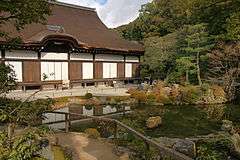Chion-in
.jpg)
Chion-in (知恩院 Chion-in) in Higashiyama-ku, Kyoto, Japan is the headquarters of the Jōdo-shū (Pure Land Sect) founded by Hōnen (1133–1212), who proclaimed that sentient beings are reborn in Amida Buddha's Western Paradise (Pure Land) by reciting the nembutsu, Amida Buddha's name.
The vast compounds of Chion-in include the site where Hōnen settled to disseminate his teachings and the site where he died.
History

The original temple was built in 1234 by Hōnen's disciple, Genchi (1183–1238) in memory of his master and was named Chion-in. While the temple was affiliated more closely in the early years with the Seizan branch of Jodo Shu, its 8th head priest, Nyoichi (1262–1321) was deeply influenced by the priest Ryōkū, a disciple of Ryōchū who was the 3rd head of the Chinzei branch of Jōdo-shū Buddhism, and disciple of Bencho. Later Nyoichi's successor Shunjō (1255–1355) advanced this further by citing a biography where Genchi's disciple Renjaku-bo and Ryōchū agree that there existed no doctrinal differences between them:[1][2]
Then Renjaku-bo said, "There is complete agreement between what Genchi and Bencho say in their basic teaching. So my disciples should from now on look at the Chinzei teaching as their own. There is no need to set up another school."
By 1450, Chion-in had become fully under control of the Chinzei branch, but had little direct control, due to the outbreak of the Onin War.[1] Numerous buildings in the complex were burnt down in 1633, but were entirely rebuilt by the third Tokugawa Shogun Iemitsu (1604–51) with the palatial structures that stand today.
Architecture

The colossal main gate, the Sanmon, was built in 1619 and is the largest surviving structure of its kind in Japan. Chion-in has a large and small guest houses in the irimoya roof style called Ohojo and Kohojo that are designated Important Cultural Heritages. Both guest houses were built in 1641.
Chion-in is home to Japan's largest temple bell, which was commissioned in 1633 and weighs 74 tons. It requires a twenty-five man team to sound it.[3]
There are two interesting features to note about Chion-in. First, the roof beams are all carved with the family crest of the Tokugawa family: three hollyhock leaves.
Another feature is the umbrella found stashed in the rafters outside the main temple. One of the architects who helped rebuild the temple placed the umbrella in the rafters to help bring rain (and thereby ward off fire).

Lastly, an interesting feature inside the temple are the very squeaky boards, an example of a nightingale floor. The wooden boards were built with metal ends that would rub against the metal joints they were attached to, created a piercing noise as people step on them. This was intentionally done so that when the Tokugawa family stayed at the temple, they could detect unwanted intruders at night.
Location
Directly to the north of Chion-in (and abutting) is the much smaller temple of Shōren-in. Directly to the south (and abutting) is Maruyama Park, which itself connects to Yasaka Shrine and thence Gion.
See also
- List of National Treasures of Japan (temples)
- List of National Treasures of Japan (paintings)
- List of National Treasures of Japan (writings)
- Pure Land Buddhism
- For an explanation of terms concerning Japanese Buddhism, Japanese Buddhist art, and Japanese Buddhist temple architecture, see the Glossary of Japanese Buddhism.
Notes
- 1 2 Dobbins, James C. (2002). Jodo Shinshu: Shin Buddhism in Medieval Japan. University of Hawaii Press. pp. 103–104. ISBN 0-8248-2620-5.
- ↑ Jonathan Watts; Yoshiharu Tomatsu (2005). Traversing the Pure Land Path: A Lifetime of Encounters with Honen Shonin. Jodo Shu Press. pp. 152–153. ISBN 4-88363-342-X.
- ↑ Hearn, Lafcadio. Lafcadio Hearn Glimpses of Unfamiliar Japan Vol 1. Brighthouse. pp. 61 (footnote). GGKEY:94BGWZS0H8R.
References
- Dobbins, James C. (1989). Jodo Shinshu: Shin Buddhism in Medieval Japan. Bloomington, Illinois: Indiana University Press. ISBN 9780253331861; OCLC 470742039
Gallery
 Daihojo
Daihojo
 Seishi-dō
Seishi-dō.jpg) Tahōtō (pagoda)
Tahōtō (pagoda)
External links
| Wikimedia Commons has media related to Chion-in. |
- Homepage of Chion-in in English
- Information and Photograph in English
Coordinates: 35°00′23″N 135°47′02″E / 35.00639°N 135.78389°E